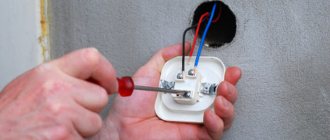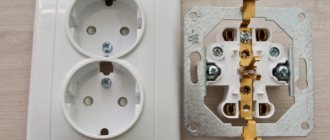Drilling a hole for an outlet in the wall may seem easy at first. But as practice shows, not everyone can perform this action. Without special knowledge and special equipment, the work is doomed to failure. However, there are good old ways that help achieve positive results without much effort.
Hole drilling tool
Cutting or breaking with a hammer or chisel is considered common practice. A chisel is used to scrape soft or hard materials. To properly drill a hole for a socket in soft material, it will be enough to use a regular drill. If you are not working with wood, choose a concrete drill bit for all materials that will be processed.
Any building materials always contain sand. And this is an abrasive that is used for metal processing. Accordingly, ordinary drills are not useful. Special drills coated with an alloy of chemical elements (cobalt, tungsten carbide) are suitable for this work.
The drills themselves, in theory, do not always cope with the task. For more efficient work, crowns in the form of cylinders are used. The best options are those coated with diamond dust. They can operate in the impact mode of a hammer drill. If you can’t drill with a regular drill, a drill can handle a hole for a socket in concrete (it can be used for concrete in window and door openings).
Required tools and materials
When large-scale electrical wiring work is being carried out, all the necessary tools will most likely already be at hand, but if the only thing on the agenda is the installation of socket boxes, then you will need the following:
- Pencil and level - for marking the wall and leveling the socket block (if one needs to be installed).
- Drill with bits for drilling socket boxes. If there are no crowns, then just a drill for concrete (or wood, in that rare case when hidden wiring is installed in a wooden wall). A hammer drill or its mode on a drill can also be useful.
- A spray bottle (you can make it homemade) for watering the crown while drilling. Prevents the appearance of dust and prevents cracking of tiles if the socket box is mounted on a kitchen apron.
- Alabaster, gypsum or cement mortar - to secure the socket box in the wall.
- A trowel or spatula with which the alabaster will be applied. Its size should allow the mixture to be placed inside the hole for the socket box.
- Socket boxes of the required design - selected depending on the wall material.
- Dowels are needed in rare cases, if the wall material is soft and installing socket boxes without additional fasteners is problematic.
A detailed overview of the tools required for installation of socket boxes in this video:
The rest does not apply to the work itself, but a broom, cleaning rags and, possibly, a vacuum cleaner will also come in handy.
Using a crown for socket boxes
If you have no idea how to drill a hole for a socket, buy a special bit from the store. It simplifies the workflow and is inexpensive. Its base is a pin that is attached to the hammer drill (screwed onto the flange), and it itself looks like a piece of pipe with a diameter of 68-80 mm. At its end there is a thread, thanks to which the product is secured. The other end is an alloy cutting element. By the way, sometimes parts of such crowns are coated with diamond dust to increase service life. The third part is the drill itself. Then the structure is secured with a screw. The drill bit helps center the bit while drilling the rosette holes. The cost of such an attachment is high, but justified, since the thing is literally an indispensable assistant for large and small repairs.
Requirements for socket boxes
There is no single set of rules describing the installation of boxes for hidden installation of electrical outlets. Rules for electrical installations require compliance with general fire and electrical safety requirements. In this sense, installing a box under an outlet is no different from installing a distribution box. There are building codes and regulations (SNiP) that determine the geometry of placement of sockets in a room. Well, common sense has not been canceled.
We will try to combine all the conditions under which the installation of socket boxes will not cause problems during the operation of electrical equipment.
An optional but useful requirement is the ability to connect several sockets together using standard clamps. This allows you to assemble a structure of any length.
Using a hammer drill
Of course, there are situations when the necessary attachment for the tool is not available. There is a way to drill without a crown. All you need is a regular drill and chisel, or attach a special attachment to the hammer drill so that it works like a jackhammer. Follow these steps:
- Draw a simple drawing of a built-in socket on the wall. To do this, simply attach the socket box to the wall and trace its contours with a pencil.
- Further along the contour you need to drill more than twenty holes.
- We knock out the crotch holes with a chisel. Of course, at first glance, such a work process may seem very labor-intensive. But since there is no other option, this will be a ruthless alternative.
Remember three basic rules for a quality installation:
| Rule #1. A correctly installed socket box should not protrude or be too recessed into the wall, that is, it should be built flush with the finished wall. A finished wall is considered to be a wall that has already been prepared for painting. We will consider cases when it is planned to lay tiles or some other false panels on the wall below. |
| Rule #2. Socket boxes must be installed strictly level, even if there is only one socket box, it must be set level to avoid difficulties in the further installation of sockets or switches. |
| Rule #3. A correctly installed socket box should hold very tightly in the socket. |
You can also add a few nuances that will help you understand what kind of electrical outlets you need; how to prepare holes (sockets) for them; how to properly insert a cable into a socket box; and how to install it correctly.
Using a grinder
If there is no suitable tool, but you need the result, you can use a grinder. Naturally, this will be extremely inconvenient, but we will consider the detailed stage of work:
- First of all, draw a diagram for quality work. The outlines of the rosette can be drawn with a pencil.
- Next, get ready to cut with a grinder. According to safety precautions, you will need to wear goggles, a respirator or a gauze bandage. Also take care of your head (you should wear a special helmet).
- We draw the grinder along the drawn contour. We make each cut carefully so that it has a certain depth. In total, you need to make at least four cuts, but more are possible.
- Take a hammer or chisel and start hammering in the center of the radius.
What to do if there is reinforcement in the wall
Sometimes even the simple process of drilling a hole for a socket box is complicated by the presence of reinforcing reinforcement in the wall. The action plan is as follows:
- A thin reinforcing lattice with a diameter of up to 5 mm is cut out with a hammer drill or gouged out with a chisel. This must be done carefully, but clearly along the edges of the sheathing.
- It is advisable to bypass thick fasteners (from 10 mm) at the stage of choosing a location for the socket. In extreme cases, it is possible to break the reinforcement using a metal drill, which is used to make a through hole in the grille. The weakened element is knocked out with a chisel and hammer, and bent with pliers.
Using a drill
With the help of a crown we get a more or less satisfactory result, but the process itself is not very simple. In some situations, the crown simply cannot cope because the brick or concrete is too rough. Therefore, you have to resort to an alternative, such as a drill.
- Mark on the wall the center of the radius of the socket box. Then start drilling the wall along the hole marked with a crown.
- Most likely, you will not be able to drill into the wall as needed. But there is a trace left on the wall from your attempts. Now it’s time for a regular drill: we drill holes with it along the edges of the mark - at least 20 of them.
- We return to the crown again, put it on and drill further. Now the result should be positive.
Hole cutting
After marking, in the marked centers of the circle it is necessary to make a hole using a drill with a slightly larger diameter than the crown drill (for example, an 8-10mm drill). We drill a hole with a margin, taking into account the length of the drill bit of the crown itself (but do not forget about neighbors and thin walls). This method is also suitable when working with a diamond core bit in drilling mode.
The process of gating. After drilling holes in the center of the future circle, you need to use a crown to go deeper into the wall a few millimeters (this only applies to the method of working with a hammer drill!). Along the intended circle, you need to drill the maximum possible number of holes to make it easier for the crown to “gnaw” the concrete.
With a diamond crown, you just need to drill - without chiselling, periodically letting the crown cool. It is worth noting that if a diamond bit gets on the reinforcement, its service life is significantly reduced.
When working with an angle grinder, the whole task comes down to making cuts in the wall to the required depth and hollowing out the area where the socket boxes will be located.
Types of holes for connection devices
The shapes of the holes mainly depend on the supplied instruments. Today, the most common shapes are round, rectangular and square. Round ones are most often used: they are more technologically advanced, and the hole for them is drilled at a time. Square holes are made as a whole or in addition to a round hole. They are usually made if there is a need for a recessed socket. This is often practiced on tiled floors. The holes are made in them in the form of a rectangular recess. Round sockets are embedded inside.
Types and characteristics of socket boxes
Modern sockets, both in appearance and in the installation method, differ significantly from those installed in Soviet-era houses.
If previously they were simply embedded in the wall without the possibility of replacement, today installing them and, if necessary, changing the socket is not particularly difficult.
And all this thanks to the socket box, which, in fact, is a box that securely holds the socket in its depths and at the same time ensures its fire safety.
Socket boxes come in different shapes and sizes, differ in materials of manufacture and installation method, so before you buy, you need to understand their types.
Selecting a socket box based on wall material
The main selection criterion is the material of the walls into which the socket boxes will be installed.
On this basis, there is the following classification of boxes:
- structures intended for installation in walls made of solid materials: concrete, reinforced concrete, aerated concrete, brick;
- glasses for walls made of composite materials: plasterboard, plastic boards, chipboard, plywood and others.
In the first case, the socket box is a round glass without any additional elements. It is fixed to the wall using mortar.
There are mounting holes in its walls or bottom for electrical wiring. When installing a socket box, it is enough to remove the jumpers and push out the plug.
To install several sockets located nearby, you can use glasses, on the side of which there is a fastening mechanism. The socket boxes are connected to each other using special grooves and combined into blocks.
Drywall boxes contain special plastic or metal clamping tabs designed to secure elements into hollow walls. The clamps are attached to screws, which rotate to adjust their position.
What shapes are the products produced in?
Round socket boxes have become most widespread. It is very easy for them to make a hole in the wall using a variety of tools.
Round glasses can be used both for mounting a single socket or switch, and they can be combined into groups, connecting to each other using docking units.
Square boxes, although not used as often, have certain advantages. Their volume is much larger, so you can hide a lot of wires in them.
They are often used to install elements of the “smart home” system. There are single and group square-shaped socket boxes designed to install up to five sockets.
There are also oval boxes on sale, which, like square ones, have a large internal space. They are convenient because you can immediately connect a double socket to them. All the products described above are mounted in walls and used for hidden wiring.
There is another type of mounting boxes that stand somewhat apart - plastic linings or, in other words, multiboxes, designed for open installation on the baseboard. They are designed for one or more outlets and are usually square in shape.
External socket boxes have two modifications - designs with installation to the middle of the baseboard or to the floor. Since multiboxes are mounted on top of the baseboard, their distinctive feature is their aesthetic appeal and original design.
Installation box size
An important parameter of socket boxes is their dimensions, which are selected based on specific installation conditions. The fork dimensions are 60-70 mm in diameter and 25-80 mm in depth.
Standard designs have external dimensions of 45 x 68 mm, but it must be taken into account that the internal depth in this case will be 40 and the diameter 65 mm.
Glasses of increased sizes, the depth of which is about 80 mm, are advisable to use when there is no distribution box in the electrical wiring, and its functions are performed by the electrical outlet itself. As for square products, as a rule, they have a size of 70x70 or 60x60 mm.
Material for making mounting boxes
The most popular are socket boxes made of non-flammable plastic. They can be installed in concrete walls and structures made of composite materials.
There are also metal boxes, which were used everywhere in the past, but today they have almost been replaced by plastic products.
Metal socket boxes are usually installed when installing electrical wiring in wooden houses. They are made of galvanized or non-ferrous metal and cannot be welded, so the connection to a metal pipe is made by soldering.
Overview of drill bits
As mentioned earlier, preparing a recess in a wall may not always be easy. But diamond crowns can make this task easier. They are made from tungsten carbide alloy and diamond dust. There are two types of them that are most in demand in the construction industry:
- Made from hard alloy. The principle of operation is impact drilling on concrete. The crown looks like a cylinder with an edge to which metal working teeth are soldered. The “bowl” is secured to the drive using an SDS tail.
- Diamond. This is a more modern and technologically advanced solution, which in the future is designed for drilling in concrete. Diamond bits also have cutting segments coated with diamond dust. Unlike the previous option, this one is operated using a shockless method, which has a positive effect on the part and the structure itself.
Overall, the choice of crown absolutely depends on the current condition of your home walls. As you have probably already seen, in some cases you can do without them. Any of the above approaches requires care and adherence to a step-by-step procedure for completing the work.
Installation of socket boxes in gypsum board
When working with drywall, the cable is laid in advance or pulled through using technical holes and broaches. In the places of future switching (connections) of the cable, or in those places where there should be a socket box, leave a supply of cable, and mark outside where this cable is located. Mark the location of the future hole for the socket box in any way convenient for you, for example, screw in a self-tapping screw in this place.
Markings for socket boxes are made in the same way as markings on concrete. The distance between the centers of the circle is the same 71mm . It is important to consider that a drilled hole cannot be fixed (or rather, nothing is impossible for a good electrician), but before you call an electrician, you need to try to do it yourself.
Holes in drywall can be made with a regular wood bit, 68mm , using a screwdriver or drill.
After drilling the hole, you need to find the necessary wires, which should be right behind the wall. It happens that they are hidden in a junction box, or hang on a cable, with the help of which the wires can be pulled to the hole. Each master has his own way of pulling wires into hidden cavities, but that's a different story.
You need to insert the wires into the socket box BEFORE installing the socket box itself, otherwise it simply cannot be done.
Now comes the fun part. The most painful procedure is the correct installation of the socket box in the drywall. This is due to the fact that different manufacturers of socket boxes for plasterboard (or wood) have lugs for securely fixing the socket box to the ceiling wall (plasterboard, plywood, or whatever you have). In some cases, because of these ears, the rosette does not fit into the prepared hole, but this problem does not occur on all rosettes!
It is best to take care of this in advance when buying socket boxes. Make sure that the ears, when open, do not go beyond the circumference of the socket itself, for example, like here
If, nevertheless, you manage to buy the “wrong” socket box, then you can use one little trick: eyelets are made in plywood or drywall at a slight angle (it is enough to make them only on one side), after which the socket box can be installed normally. The socket box should fit into the hole normally at an angle. The main thing is not to overdo it and not to make a hole with a larger diameter than the outer edges of the socket box.
Making a hole in the tile for the socket yourself
In this regard, it significantly saves money and time. But for successful work you will need to follow some recommendations. We don’t need a switch, a socket, or holes, unlike the socket box and some other parts.
Installation of socket boxes is carried out using a hammer drill. With it, work will be more efficient. In addition to this, you will need:
- Crowns.
- Drill.
- Hammer.
- Chisel.
The work is performed in the following sequence:
- Determine a suitable location for the socket and switch (installation standard is from 30 cm from the floor, and the switch is up to 80 cm).
- Mark the locations of switches and outlets on the wall.
- Before starting work, cover furniture to protect it from dust.
- Do not neglect the rule of your own safety (wear a special mask and goggles).
- Let's start drilling with a crown. Switch the hammer drill to impact mode.
- During operation, do not press hard on the drill, this may lead to damage and breakage of the tool.
- We knock out the remaining piece of concrete with a chisel or hammer.
Preparatory work
Before starting installation work, you need to prepare tools and materials. You should decide on the areas where the sockets will be installed. It is necessary to draw a diagram showing the installation locations of sockets, switches and wire lines.
Note! In residential premises, it is customary to install sockets at a height of 30–40 centimeters from the floor. If we are talking about a bathroom, toilet, corridor or other room for utilitarian purposes, the level of fittings must be chosen based on practical need.
When laying wires, you should follow some rules:
- The wiring should be located 15 - 20 centimeters from the ceiling.
- The wires should only diverge vertically or horizontally. Building codes prohibit diagonal laying of wires, creating zigzags or twists between wires.
- The distance between the grooves and the gas pipeline should not be less than 35 centimeters.
Tools and materials
Installing a socket in a wall requires the following tools and materials:
- devices for creating grooves (grinder or wall cutter);
- hammer drill for drilling sockets;
- a crown for working with concrete, a Pobedit drill, a spatula-shaped attachment;
- knife, wire cutters, screwdriver;
- putty knife;
- roulette;
- plaster and alabaster;
- deep penetration primer composition;
- socket box;
- wires;
- pencil.
How to secure socket boxes
The socket boxes are fixed with a solution diluted from putty, alabaster and water. After preparing the solution using the dabbing method, secure the device and wait until it dries completely. Then you can proceed to installing the socket.
Preparing holes for socket boxes in any type of wall, including concrete, will not be too labor-intensive if you use the right tools. However, even without special crowns, you can cut out a recess, but this will require more time and effort.
Embedding a socket box in concrete
The best way to secure socket boxes is to embed them in the hole using alabaster or rotband. A small life hack - so that the solution does not harden too quickly and you do not have to wait a day - you need to mix alabaster with rotband.
First, use a vacuum cleaner to remove all dust from the hole and moisten (prime) the hole with water. And only after this, we apply the solution with a small spatula, spreading it along the inner walls of the hole. The solution should be thick enough not to leak out of the wells. It is important to understand that the area of contact between the solution and the socket box should be maximum! Plus, coat the socket boxes themselves with the mixture. The solution will envelop the socket box from all sides and adhere well to the base of the wall, only then can we say that the socket box is installed efficiently!
Using a large spatula, remove excess mortar while leveling the surface of the wall. Before this procedure, it is necessary to remove or screw in all the screws of the socket box.
Laying the cable in the socket box. It is best to lay the cable in an already installed socket box; the windows for the cable are easily knocked out with a screwdriver, and it is better to make channels for pulling the cable between the socket boxes in advance. When the solution has cooled, you can safely insert the cable into pre-made holes or recesses.
If you don’t have that much time and the cable needs to be installed together with the socket box, try to align the socket boxes as accurately as possible. You can insert the cable into any hole, but it is better not to use the side windows for this, so that there are no difficulties with the subsequent installation of sockets.
Important! The entry of the cable into the socket box should not in any way interfere with the future socket, especially from the side of the spacers. A very common mistake when installing socket boxes is to break the wires with a spacer from the socket - in this case, a dangerous potential may appear on the socket body, or a short circuit may occur when the electricity is turned on.
Epoxy resin
Repair compounds for sealing cracks in concrete based on epoxy resin are used to eliminate small cracks in a monolithic foundation; this mixture can also be used to repair the foundation in a private house.
Work to eliminate defects consists of three stages:
Installation of socket boxes in a concrete/brick/aerated concrete wall. Review of crowns.
- Cleaning the area from small fractions.
- Drying the problem area.
- Filling the crack with epoxy resin.
Cleaning the problem area is done using a stiff metal brush. It is necessary to treat the inside and the surface around the crack. Removal of fine fractions and dust is carried out by blowing, after which you can dry the area with a construction hairdryer.
T6.1 Drilling a niche for a socket box in concrete
Before repairing cracks in concrete on the street using epoxy compounds, it is necessary to place special nozzles along the entire length of the problem area with a spacing of 30 cm. The installation of nozzles along the height of the wall begins from the lower section of the crack, 30 cm from the level of the blind area.
Socket boxes in concrete. easy and fast
Epoxy adhesive is formed by mixing resin with a hardener. This mass is injected into the fracture through nozzles, starting from the bottom. The solution gains full strength within five days, after which the nozzles are removed (cut off), and the surface of the repaired area is rubbed using an epoxy solution.
READ Cut a corner on the suspended ceiling plinth
What do you need to know before starting work?
Before starting work, you need to know 2 things: what to drill with, and how to drill a hole so as not to injure yourself or others. We will talk about safety precautions in more detail below, but now we will focus on the tool. There are many options here. It all depends on what your walls are made of. If these are walls no more than 30 cm thick, then an ordinary drill or hammer drill will be enough. And if you need to make a hole on an internal non-load-bearing wall (for example, between a bathroom and a kitchen), then you can do without it.
READ How much oil is poured into a walk-behind tractor engine
If the walls are thicker than 30 cm and are made of concrete monolith or sand-lime brick, then a more serious tool is needed. A 1 kW hammer drill and a set of diamond or pobedit bits are quite suitable for this purpose. The task will be long, tedious and dirty, but quite doable. Well, if everything is really sad and you need to drill through very hard concrete or reinforced concrete, then you need a drilling rig called a motor drill. Its power is 5-8 kW and this machine for drilling holes in concrete breaks through everything.











